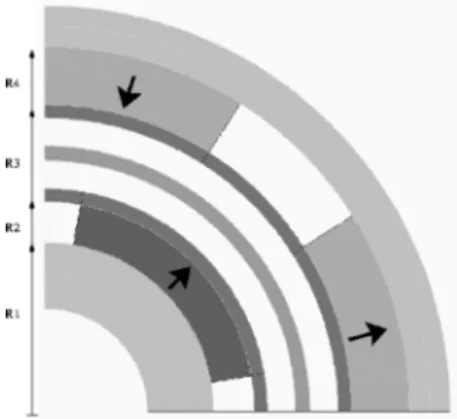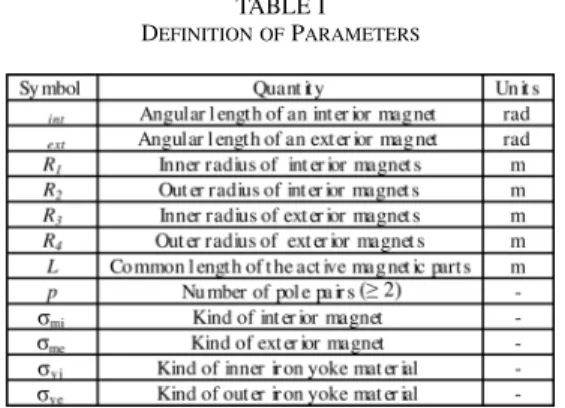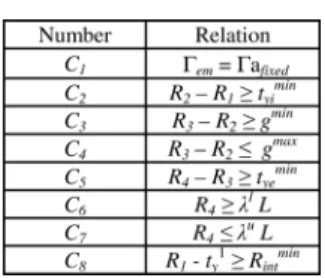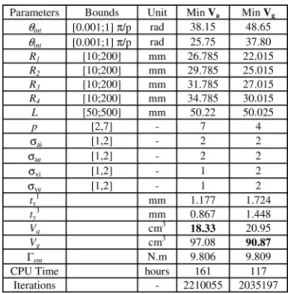HAL Id: hal-01522924
https://hal.archives-ouvertes.fr/hal-01522924
Submitted on 15 May 2017
HAL is a multi-disciplinary open access
archive for the deposit and dissemination of
sci-entific research documents, whether they are
pub-lished or not. The documents may come from
teaching and research institutions in France or
abroad, or from public or private research centers.
L’archive ouverte pluridisciplinaire HAL, est
destinée au dépôt et à la diffusion de documents
scientifiques de niveau recherche, publiés ou non,
émanant des établissements d’enseignement et de
recherche français ou étrangers, des laboratoires
publics ou privés.
Some Co-Axial Magnetic Couplings Designed Using an
Analytical Model and an Exact Global Optimization
Code
Julien Fontchastagner, Yvan Lefèvre, Frédéric Messine
To cite this version:
Julien Fontchastagner, Yvan Lefèvre, Frédéric Messine. Some Co-Axial Magnetic Couplings
De-signed Using an Analytical Model and an Exact Global Optimization Code.
IEEE
Transac-tions on Magnetics, Institute of Electrical and Electronics Engineers, 2009, 45 (3), pp.1458-1461.
�10.1109/TMAG.2009.2012678�. �hal-01522924�
Some Co-Axial Magnetic Couplings Designed Using an Analytical Model
and an Exact Global Optimization Code
Julien Fontchastagner
1, Yvan Lefèvre
1, and Frédéric Messine
2Laboratoire Plasma et Conversion d’Energie (LAPLACE), Université de Toulouse-CNRS, BP 7122, 31071 INPT-ENSEEIHT, Toulouse Cedex 7, France
Institut de Recherche en Informatique de Toulouse (IRIT), Université de Toulouse-CNRS, BP 7122, 31071 INPT-ENSEEIHT, Toulouse Cedex 7, France
The purpose of this paper is to use a new rational approach for the design of some magnetic couplings. Our method is based on the association of analytical models and an exact global optimization algorithm named IBBA and developed by the third author. The analytical model presented in this paper is more sophisticated than those previously dealt using IBBA. Therefore, some under and over estimating functions have been constructed for those particular problems of design in order to improve the convergence of IBBA. Some optimal results highlight the efficiency of this approach.
Index Terms—Analytical model, Branch&Bound, exact global optimization, interval arithmetic, inverse problem, magnetic coupling.
I. INTRODUCTION
T
HE problem of design is here understood and formulated as an inverse problem. This methodology is well adapted to the design of some electromechanical actuators, see [1], [2]. In order to solve exactly the so-generated global optimization problems, a particular deterministic global algorithm based on a branch and bound technique and on interval arithmetic has been developed by the third author, [3]. In [1] and [2], IBBA was associated with analytical models of permanent magnets motors to find optimized solutions of design.The associated analytical models need several assumptions to get simplified expressions of electromechanical quantities such as the flux and the torque. Therefore, when optimal solutions of a design problem are obtained, it is often necessary to validate them by means of a numerical model. In order to reduce the use of a numerical model, an analytical model that needs fewer assumptions is proposed. This model is based on the method of separation of the variables for solving Poisson’s equations. It gives results that are very close to those obtained by using a finite-element analysis (FEA), [4], [5].
In this paper, IBBA is used once more time but applied to a new application of design concerning magnetic couplings. That is the first time that IBBA is associated with such com-plicated analytical expressions and thus, some ideas for con-structing over and under estimating functions have been intro-duced. Due to the particular geometrical structure of such de-vices, it is possible to solve Maxwell equations by separation of the variables. The analytical expressions of electromechanical quantities are more complicated than those employed in [2] but are far simpler than the ones in [4] and [5]. In our knowledge, no other optimization method has been used to solve exactly those kinds of design problems.
Fig. 1. Geometry of the considered magnetic coupling.
The analytical model is presented in Section II. In Section III, the principle of IBBA is summarized. Its adaptation to our problem is detailed. Section IV presents some magnetic cou-plings which are optimized using this methodology.
II. MAGNETICCOUPLING
Magnetic coupling are very useful devices for many appli-cations as in chemical and petrochemical industries. In an ef-fort to prevent leakage of hazardous fluids from piping systems, the use of magnetically driven sealless pumps has become more common. Magnetic couplings are used in them to transmit rota-tional motion without mechanical contact. The studied structure is a co-axial magnetic coupling as shown on Fig. 1. It consists of two rings of permanent magnets separated by a containment can. On each side of it, we find an airgap and a binding band.
A. Parameterization
In order to calculate the torque produced by such a device, one must first choose the parameters required for the computa-tion of the magnetic fields inside it. On Fig. 1, we can see that the two rings of magnet are separated by five concentric areas: two binding bands, two airgap zones and, in the middle, the con-tainment can. These zones are all nonmagnetic, thus we include them into only one big area named airgap thereafter. Moreover, we can consider that the two rings of iron yoke have an infinite permeability. Thus, we can take into account only three areas: is the inner ring of magnets, the outer one and
TABLE I DEFINITION OFPARAMETERS
the airgap. Our structure can be described by 12 param-eters (7 reals, 1 integer, 4 categorical variables, see Table I).
B. Modeling
In [4] and [5], an analytical model of the magnetic field in permanent magnet motors is proposed. In [5], a magnetic scalar potential formulation is used. We find the magnetic vector po-tential formulation described in [4] suitable for magnetic cou-plings.
1) Magnetic Vector Potential Formulation: As the two
ar-matures of a magnetic coupling rotate at the same speed, the magnetic field can be considered static in a reference fixed on one of them and static Maxwell equations may be applied [4]. The constitutive laws of magnetic media are as follows:
— in the airgap
(1) — In the permanent magnets ( and )
(2) From the Gauss’s law of magnetism, we can derive the mag-netic field from a magmag-netic vector potential, . Owing to the geometry of the magnetic coupling (see Fig. 1), we can assume a translational invariance along the Oz axis. Thus, the vector po-tential has only one non-null component: . The magnetic po-larizations of magnets are assumed to be purely radial. They have a spatial period equal to in the direction. Therefore, in polar coordinates, we can write the harmonic series [4]
(3)
The partial differential equation governing is [4] in
otherwise. (4) To these equations, we must add the boundary conditions and the continuity conditions between two media. As the inner and outer yokes are assumed to have an infinite permeability, we have on surface boundaries at and :
(5)
where is the value of in a media , . Thus, the continuity conditions of the magnetic field must be applied on
the interfaces at and . For instance, on interfaces , we have
(6) Because , the method of separation of the variables gives the form of the analytical expression of in :
(7)
The and coefficients are null in . In and , we have the following relations:
(8) where is the angular gap between the two armatures and and are respectively the radial polarization of inner and outer magnets. The value of the torque is maximum when (see Fig. 1). Thanks to relations (5) and (6) the values of , , , and coefficients appearing in relation (7) can be known by solving the two equations
(9) where
2) Magnetic Torque: The magnetic flux density in each can be calculated from the magnetic vector potential .
Hence, by applying the Maxwell stress tensor in the airgap, the torque can be obtained. Comparisons with FEA show that we can take into account only the first harmonic . Thus, using MAPLE, we can get an analytical expression of the torque (10)
(10)
3) Thickness of Iron Yokes: We present here a simple method
which allows to calculate an approximation of the thickness of each iron yoke . Indeed, the mean value of magnetic flux density in the yokes must be less or equal to the maximum value above which the iron is definitely saturated.
In the yoke, the maximum value of magnetic flux is and the magnetic flux per pole is given by
(11)
where is the maximum value of the magnetic vector potential and can be obtained from relations (7) and (9). Ac-cording to the Gauss’s law of magnetism we have . Eventually, the analytical expression of the thickness of the inner yoke is
where is the maximum flux density in the inner iron yoke. An analogue expression for the thickness of the outer yoke
can be derived.
III. FORMALIZATION OF THEDESIGNPROBLEM
A. Formulation
An inverse problem is formulated as mixed constrained global optimization problems defined as follows:
subjected to: (12)
where is a real function; represents an enumerated set of categorical variables, that is for example the type of magnet; and the boolean set which is used to model, for example, the fact that an actuator is with or without slot(s).
B. IBBA Algorithm
Interval analysis was introduced by Moore in 1966 [6]. All real values are enclosed by an interval where the bounds
TABLE II LIST OFCONSTRAINTS
are the two closest floating point numbers. Expanding the classical operations—addition, subtraction, multiplication and division—into intervals, defines interval arithmetic. A straight-forward generalization allows computations of reliable bounds of a function over a hypercube (or box) defined by an interval vector. Moreover, classical tools of analysis such as Taylor expansions can be used together with interval arithmetic to compute more precise bounds [6], [7].
The principle of IBBA is first to bisect the initial domain into smaller and smaller boxes and then, to eliminate the boxes where the global optimum cannot occurs:
• by proving, using interval bounds, that no point in a box can produce a better solution than the current best one; • by proving, with interval arithmetic, that at least one
con-straint cannot be satisfied by any point in such a box. To accelerate the convergence, constraint propagation tech-niques are used in some steps of IBBA [8]. Such interval Branch and Bound algorithms guarantee to produce an -global optimal solution, where is the maximal error on the objective function value; is fixed by the user of IBBA. Actually, IBBA was used to solved exactly some non-homogeneous mixed con-strained global optimization problem with almost 25 variables and 15 parameters (taking between few seconds to 6 days of computing times). The difficulty to solve a problem depends on the number of variables and of constraints but also on the com-plexity of the analytical equations. Indeed interval arithmetic has not all the properties of the classical one (for example it is sub-distributive). Therefore, bounds computed using interval arithmetic can be very large [6]. This is the main difficulty that we have to deal with in this work. For details on such an algo-rithm see [3] and [7].
C. Application and Adaptations of IBBA
Our input vector is defined by the parameters used in Table I. The minimum value of the volume of magnets or the global volume is searched
(13) (14) Each solution must satisfy an equality constraint upon the fixed electromagnetic torque (10), and seven geometric in-equalities (see Table II), is the value of torque imposed by the schedule of conditions; , , , and are respectively the minimum values of the thicknesses of the in-terior magnets, the airgap, the exin-terior magnets and the inner radius of our device; is the maximal value of the airgap;
TABLE III RESULTS
In front of the complexity and the strong nonlinearity of many expressions (criteria, torque, thicknesses of yoke), the use of in-terval arithmetic is not easy. The returned bounds are not effi-cient enough. Hence, to improve the convergence of IBBA, we propose to intersect with an undervaluation and an overvaluation of it . We use for
(15) This procedure replaces the constraint . An example can ex-plain it. If, during the process, our one-column input vector is:
Therefore, the obtained intervals of the torque without and with these limiting actions are, respectively:
A same method has been applied to and , [9].
Fig. 2. Geometries of the two optimal solution (MinV and Min V ).
IV. RESULTS ANDCONCLUSION
To illustrate the use of this new IBBA algorithm, let us con-sider the following optimal design problem. It deals with the minimization of our two criteria ( and ). The equality constraint is true when the torque is equal to 10 0.2 N m. The magnets can be in Sm2Co17 (if or ) or in NdFeB (if or ). The iron yokes can be in steel z15 (if or ) or in z30c13 (if or ). The initial bounds of our parameters and the obtained results are shown in Table III and on Fig. 2. First we can see that the value of torque is close to the allowed lower limit (9.8 N m). We can also note that the obtained numbers of pole pairs are clearly different (4 and 7). Moreover the kinds of steel of yokes are different.
These results show the efficiency of our approach. Indeed without the dimensions, the integer and the categorical parame-ters describe a set of 116 different geometries of mag-netic couplings. The method is able to find the most efficient one and the result is guaranteed.
REFERENCES
[1] F. Messine, B. Nogarede, and J.-L. Lagouanelle, “Optimal design of electromechanical actuators: A new method based on global optimiza-tion,” IEEE Trans. Magn., vol. 34, no. 1, pp. 299–308, Jan. 1998. [2] E. Fitan, F. Messine, and B. Nogarede, “The electromagnetic actuator
design problem: A general and rational approach,” IEEE Trans. Magn., vol. 40, no. 3, pp. 1579–1590, Mar. 2004.
[3] F. Messine, “A deterministic global optimization algorithm for design problems,” in Essays and Surveys in Global Optimization, C. Audet, P. Hansen, and G. Savard, Eds. Montreal, QC, Canada: GERAD, 2005, pp. 267–294.
[4] M. Couderc, C. Henaux, and B. Nogarede, “Analytical modelling of high speed electrical machines in view of their optimal design,” pre-sented at the IEEE 32nd Ann. Conf. Ind. Electron. (IECON), Paris, France, 2006.
[5] Z. Q. Zhu, D. Howe, B. Ekkehard Bolte, and A. Bemd, “Instanta-neous magnetic field distribution in brushless permanent magnet dc motors, Part I: Open-circuit field,” IEEE Trans. Magn., vol. 29, no. 1, pp. 124–134, Jan. 1993.
[6] R. E. Moore, Interval Analysis. Englewood Cliffs, NJ: Prentice-Hall, 1966.
[7] H. Ratschek and J. Rokne, New Computer Methods for Global
Opti-mization. Chichester, U.K.: Ellis Horwood, 1988.
[8] F. Messine, “Deterministic global optimization using interval con-straint propagation techniques,” RAIRO Oper. Res., vol. 38, no. 4, pp. 277–294, 2004.
[9] J. Fontchastagner, “Résolution du problème inverse de conception d’actionneurs électromagnétiques par association de méthodes déter-ministes d’optimisation globale avec des modèles analytiques et numériques,” Ph.D. dissertation, Elect. Eng. Dept., Univ. Toulouse, INPT, Toulouse, France, 2007.



